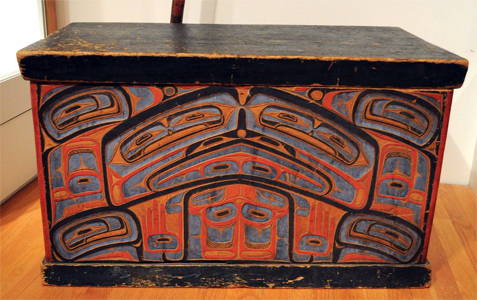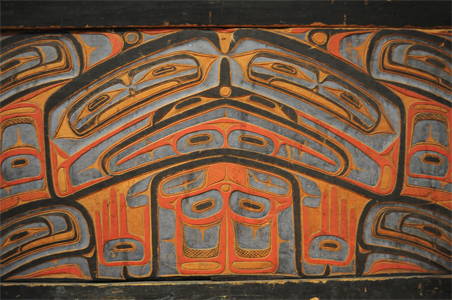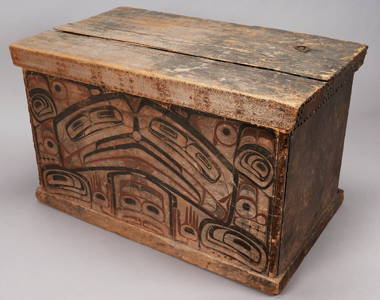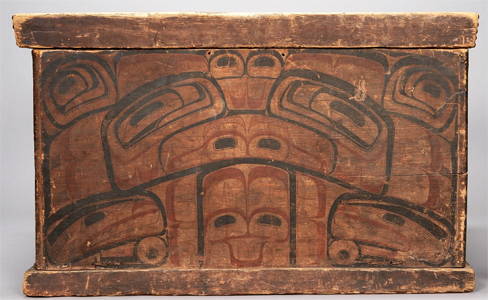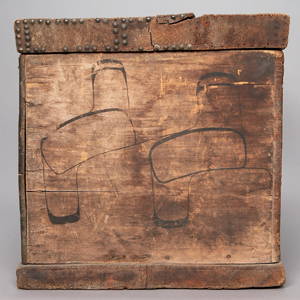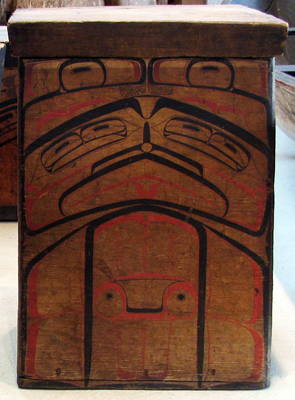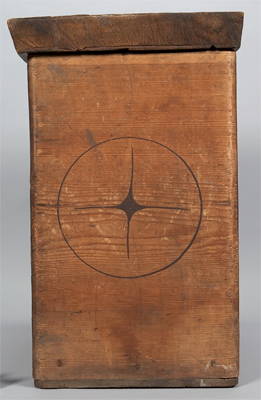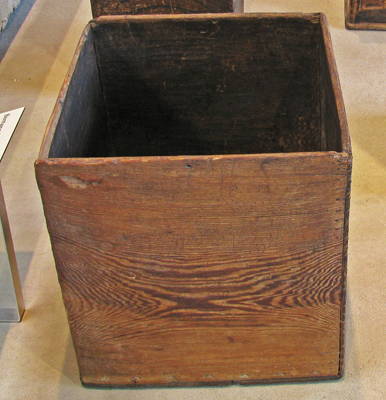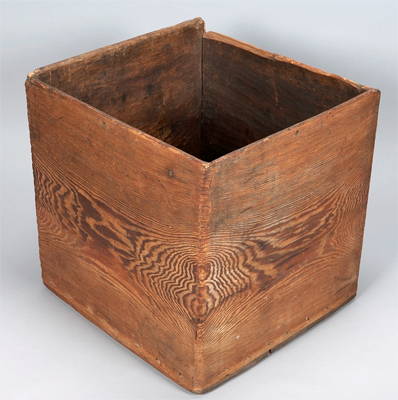Back to Don's Maps
 Back to Archaeological Sites
Back to Archaeological Sites
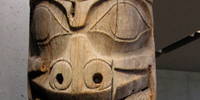 Back to Pacific NW Coast index
Back to Pacific NW Coast index
Cedar Bentwood Chests of the First Nations of the Pacific North West
Although the art of the First Nations of the Pacific Northwest Coast has long been recognised, little attention has been given to how they actually made things. Most people will think of their massive totem poles, dugout canoes and sculptural masks, but the kerf-bent wooden box is the more ingenious example of a woodworking technology developed through eons of practice. It consists of just two planks of cedar. One is the flat bottom, rabbeted all around to receive the sides. The other is a single plank that has been deeply kerfed in three places, plasticised by controlled steam and bent at right angles to form four sides. The last corner is sewn or pegged together. The result will hold water.
These richly decorated boxes range in size from a few inches to several feet. Some have flat sides, some bulge outward. Some have lids, some have sweeping curves cut into their top edges. They stored the food and possessions of everyday life as well as the ceremonial regalia of the winter dances, they were cooking pots and serving dishes, and finally they were coffins.
But they were not merely containers as we think of containers, for their intricate motifs also represented the personal crests of the owner. These crests were displayed proudly, for they served to verify rank as well as spiritual power.
The First Nations population probably never exceeded 100 000 on the whole coast of Alaska, British Columbia and Washington. They lived scattered in hundreds of villages separated by at least six different languages and dozens of dialects. That this sparse population had the time to make great quantities of boxes testifies to the material richness of their seacoast and rain-forest habitat. As Haida carver Bill Reid, who spent two years carving a 57 foot totem pole, has written, 'Even today, only a stupid man could starve on this coast, and today is not as it was.'
They could support a whole class of artisan specialists who, freed from the urgency of subsistence work, transformed the gifts of the forest into concrete expressions of their cultural values. The elite, in turn, would hoard the treasures they had commissioned and convert this wealth into status at the potlatch, by giving it all away, in the expectation of receiving even more in return.
Although it used to be thought that woodworking arts were quite unsophisticated until the introduction of iron tools by European explorers after 1770, recent archaeology shows otherwise. This culture and its art has been on a high level for several thousand years. Iron tools had been known on the coast for about two hundred years before direct European contact. When Europeans traded metal tools in quantity for furs and artefacts, the First Nations culture reached a lavish sophistication previously not feasible. Yet this coast was still the remotest corner of the world, and remained essentially intact for almost another century. About 1850, gold was discovered inland. White settlers came to stay. There followed a century of terrible repression, while the Canadian authorities tried to 'civilise' the heathens by outlawing their language, customs and ceremonies. Finally, as scholars began to recognise the value of what was being crushed, the political changes of our own era also stirred the First Nations people.
Text above: adapted from Davidson (1980)
It is a rare but thrilling and deeply satisfying experience when I come across such well written and informative prose, which analyses and makes crystal clear the underpinnings of a complex situation - Don )
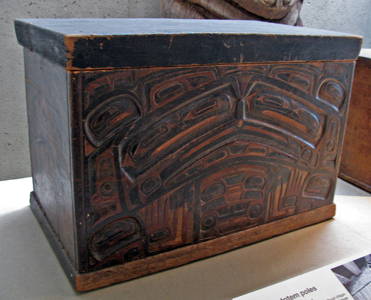 ts'uu ging.uula Guudang
ts'uu ging.uula Guudang
Cedar Bentwood Chest
Culture: Haida
Haida Gwaii, BC
Yellow and red cedar ca 1850
MOA purchase, 1971 (Walter C. Koerner Funds)
A9416 a-b
The bentwood box as a holder of ideas, as well as of material goods, is dramatically expressed by storage chests such as this one. The carved and painted compositions are at once highly stylised and infinitely varied. They belong to a visual tradition that has persisted for centuries, yet they also reveal the hand of individual painters who helped to shape this complex art.
Photo: Don Hitchcock 2012
Text: Display, Museum of Anthropology, University of British Columbia
 This is the design of the front face of the box above.
This is the design of the front face of the box above.
Large wooden, rectangular, carved bentwood box with lid (parts a-b). Part a is a bent wood box carved in shallow relief with figures detailed in black and red paint. Each side holds a different design. The front has a bird motif, the back has a whale while the sides hold a beaver. Carved in Northwest Coast stylised designs. Part b is a flat rectangular lid painted black. All sides are painted in red, black and blue. The bottom is flanged to accommodate the sides and sewn.
Bentwood storage chests were the property of high ranking and wealthy individuals, and were used to store valuable masks, rattles and ceremonial clothing.
Elaborate designs on Northwest Coast boxes and chests are thought to be highly stylised animal, bird or sea creatures. Native interpretations elicited when many museum specimens were collected are contradictory. It has been suggested that the designs may have been deliberately obscured to allow the owner (who was not the artist) to claim the design to be anything he wished.
Made by Albert Edward Edenshaw (Maker) in Masset, British Columbia, Canada ?
Owned by W. R. Lort before October 14, 1971
Material: metal, paint and cedar wood
Manufacturing Technique: adzed, steamed, painted, sewn, nailed, pegged, bent and kerfed
Part A: height 614 mm, width 1019 mm, depth 578 mm (box)
Part B: height 86 mm, width 1034 mm, depth 332 (top? )
Part C: height 86 mm, width 1034 mm, depth 277 mm (bottom? )
Condition: good
Accession number: 2103/1 a-b
Acquisition Date: on October 14, 1971
Photo: Don Hitchcock 2012
Text: http://www.rrnpilot.org/items/4589
(Note the very close similarity of the designs carved into the box above and this box by Captain Richard Carpenter below - Don )
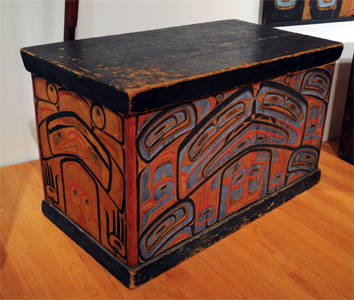 Cedar Bentwood Box
Cedar Bentwood Box
Made by Captain Richard Carpenter (Du'klwayella), Heiltsukw, Waglisla, 1841–1931
Date c. 1860
Red cedar, yellow cedar, paint
Current location: Seattle Art Museum
Accession number 86.278
Object history Gift of John H. Hauberg and John and Grace Putnam
Photo (left top): http://www.museumsyndicate.com/item.php?item=54294
Photo (right top): Joe Mabel, licensed under the Creative Commons Attribution-Share Alike 3.0 Unported license.
Photo (left bottom): Joe Mabel, licensed under the Creative Commons Attribution-Share Alike 3.0 Unported license.
Text: Wikipedia
Making a bentwood box
Text and photos from the excellent reference Davidson (1980)
For bentwood boxes and totem poles western red cedar and yellow cedar remain the material of choice. The old way was to burrow two deep holes into the living trunk, one near the ground and the other as high up as the boards would be long. Planks could then be split off using a graduated set of seven yew-wood wedges and a stone maul, and the tree would live on. The trees were much bigger then, 10 feet and more in diameter.Aside from living memory and contemporary experience, information about the old ways of woodworking comes mainly from Franz Boas, the German-born anthropologist who studied the Northwest Coast tribes between 1885 and 1930. By the time of Boas' observations, metal tools were readily available and the trees were usually felled. They were then made to lie with their smooth, weather side upward. The seven graduated wedges were driven in along a line four finger-widths above the center of the log. When the tree began to open, a round crab-apple or yew-wood stick about 6 inches thick was inserted across the horizontal crack, and two men pounded on blunt wedges that were hollowed to fit around the 'spreading stick'. Planks were always split from the branch end down, to prevent the plane of fissure from turning outward, and to avoid producing a plank that was short and thin at one end.
The first plank removed was three finger-widths thick, because it never ran quite parallel to the splitting plane. Subsequent planks ran more nearly parallel and could be as thin as one finger-width - if the cedar was good. Planks of 20 feet and longer were split in this way. Most boards were split tangentially - that is, the growth rings intersected the face of the board at a small angle. But the boards intended to become bent boxes were split radially, through the centre of the tree, crossing the growth rings at right angles.
The wood had to be seasoned, since green wood is liable to shatter when forced into the tight bends necessary for wooden boxes. The plank to be used was shaved and adzed to the right thickness, perhaps half a finger thick, and trimmed to a rectangular shape.
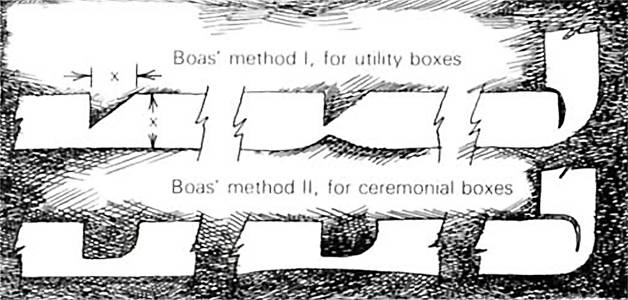
The next step was most critical, that of cutting the kerfs where the future corners would be. Boas describes two styles of kerfing. The simplest is a V cut with one vertical side, about half way through the board, as wide as the board is thick. The outside of the board would be shaved back on both sides of the V cut. Museum specimens show that this method was reserved for utility boxes for gathering, storing, and cooking food. The wood at the corners is quite thin and would have bent easily with a minimum of steaming, but the result is fragile - many surviving examples are cracked or broken.
In the second method Boas recorded, the kerf looks like a dado with one rounded corner. It was made by incising a narrow vertical kerf, then working it wider with the knife along a curve reaching down to the original cut. The board was also thinned opposite to the kerf. This method was reserved for decorated chests and serving dishes. It required more skill to make, but produced a more durable and aesthetically pleasing wrapped corner.
Photo and text: Davidson (1980)
Even so, a study of 99 boxes at the National Museum of Man in Ottawa isolated 11 different kerfing styles.
In old boxes, as today, the fitting at the fourth corner is a rabbet joint, the rabbet being as wide as the kerfed board is thick, and half as deep. The other end was and is left blunt to butt up against this tongue.
Steaming used to be a difficult and time consuming process, with hot rocks used to heat the water, but now steam is fed via a rubber hose to the wood. When the box is bent into a rectangle, the final corner is secured with tapered cedar pegs. A rope was wrapped around the bent form several times and tightened so that the box would not twist out of shape. To keep it square, four cedar sticks of equal length were wedged diagonally inside, two across the top and two across the bottom. The bottom was shaped from a block of wood rabbeted down half a finger-width around the edge. It was made to fit up tightly into the box and then pegged securely to the sides. The lid was sculpted to fit tightly over the top. Stale human urine was used to help in bending the wood and preventing checking, and urine was also used when spreading canoes. The skin from dogfish, a member of the shark family, was used to sand wood to a smooth finish. Food was cooked in kerf-bent boxes by filling the box with water and food, and bringing to the boil by tossing in hot rocks.

It is certainly possible to simply dig out three channels in a length of board, heat the wood in a steam box, bend the wood, and secure the other end, then attach a base and make a top.
Doing it well is another matter.
This diagram shows what is necessary to get a tight fit, with no gaps. Notice that the profile of one side of the channel is curved, while the other is straight. Thus when the board is bent, the thin wood bends in an arc, which is supported by the corresponding arc on one side of the channel, leaving little or no gap to be filled with pitch or filler of some kind. This method will give a solid and long lasting, hard wearing corner.
Photo: Davidson (1980)
Text for this image: Don Hitchcock
 ts'uu ging.uula Guudang
ts'uu ging.uula Guudang
Cedar Bentwood Chest
Culture: Haida
Old Massett, Haida Gwaii, BC
Yellow and red cedar ca 1870
MOA purchase, 1960 (H.R. MacMillan Funds)
A7103 a-b
Great bentwood chests were considered heirlooms, treasured within families and often passed down through the generations.
This unique chest, with its projecting bear snout and paws, was collected in the 1870s by the Reverend W.H. Collison while he was a missionary at Old Massett. A photograph taken in the village in 1884 (see below) shows this same chest inside a Haida family's lineage house.
Photo: Don Hitchcock 2012
Text: Display, Museum of Anthropology, University of British Columbia
 Another version of the box above.
Another version of the box above.
Rectangular bentwood box (part a) with lid (part b). The front is carved in high relief of a bear motif with a human figure in its mouth and eagle heads for eyes. The front is painted in blue, black and red in Northwest Coast stylized designs. The sides, back and lid are undecorated.
Made in Haida Gwaii, British Columbia, Canada before 1900
Collected between 1873 and 1922
Owned by William Henry Collison and William Edwin Collison
Owned by Joyce Collison and A. M. Budinich before February 1960
Received from A. M. Budinich (Seller), Joyce Collison (Seller) and H. R. MacMillan (Funding source) during February 1960
Identification Number: A7103 a-b
Manufacturing Technique: adzed, painted, carved, kerfed, steamed, pegged and bent
Part a: height 620 mm, width 1000 mm, depth 580 mm
Part b: height 90 mm, width 1035 mm, depth 610 mm
Condition: fair
Accession number: 20/62 a-b
Creation Date: before 1900
Photo and text: http://www.rrnpilot.org/items/3442
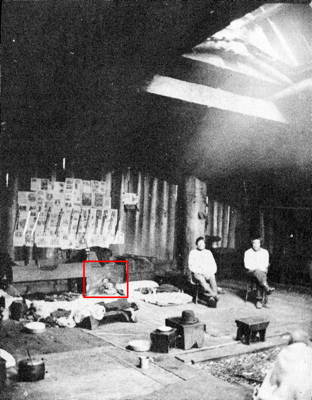
Interior view of Chief Anetlas' "Star" House, with a red rectangle outlining the box in the photo above.
Richard Maynard took this photograph at the Haida village of rad raci7waas (Massett) in 1884. These modified Victoria cards (measuring 82 mm x 125 mm) are the earliest extant photographs that record the interior of houses on Haida Gwaii. The view inside Chief Anetlas' house is less well-known but documents three people, Chief Anetlas and another man sitting on chairs. A third man, wearing a blanket, is squatting beside the central fire pit. The seated men are relaxed with legs crossed and arms folded and appear to be comfortable with having their photograph taken.
These photographs are all the more remarkable when you consider that an estimated exposure of three to five minutes was required, for example, to make the photograph of Chief Wi:ha's house.
Text: Savard (2005)
Source: Royal British Columbia Museum PN5324 and PN5325, in Savard (2005)
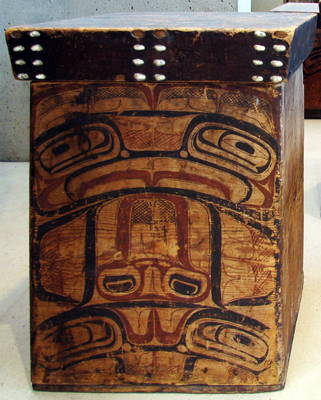 Galüünx (Bentwood Box)
Galüünx (Bentwood Box)
Tsimshian, ca 1850
A8227 a-b
(Galüünx can also be metaphorical, as in a 'box of treasure' such as crests, territory, names, see http://www.jlsreport.com/?p=3480)
This box is painted with a dark-red hematite, or iron oxide, which is a natural pigment prepared and used for centuries by Northwest Coast artists.
Tall square bentwood box (part a) with a slightly flared lid (part b). The front and back are painted red and black in different Northwest Coast stylised distributive designs. They both have bird-like features with the front depicting an eagle? The remaining two sides have decorative hatching consisting of seven to ten fine diagonal black lines forming a zigzag border down the outer edges; inner area is unpainted. The box is pegged together at the side seam and on the bottom. The lid is inlaid with three sets of eight operculum shells on the front and the back.
Bentwood boxes were used primarily for storage of food, implements, clothing and valuables. They were also used for cooking and serving food. They sometimes served as furniture or room dividers. They were also used as trade goods or gifts, and were symbols of wealth and prestige. Boxes used for ceremonial purposes were usually more highly decorated than those for everyday use.
Bentwood boxes were used for storage, trade, status, and ceremony.
This box was made in Port Simpson (previously Lax Kw'alaams), British Columbia, Canada.
Owned by Wilhelm Helmer before November 10, 1962
Received from Wilhelm Helmer (Seller) and H. R. MacMillan (Funding source) on November 10, 1962
Manufacturing Technique: adzed, kerfed, bent, steamed, pegged, painted and inlaid
Part A: height 615 mm, width 480 mm, depth 450 mm
Part B: height 100 mm, width 540 mm, depth 490 mm
Condition: good
Accession number: 86/1 a-b
Photo: Don Hitchcock 2012
Text: http://www.rrnpilot.org/items/8200
Cedar Bentwood Box
Coast Salish: Quwutsun'
A8211 a-b
(Note that the lid has been turned through 180° between the two photo sessions - Don )
Rectangular bentwood box (part a) with lid (part b). The front and back are painted red and black in different designs. The front has an elaborate design containing bird and human features with mouse woman (?) in profile along the side edges. The back depicts a killer whale. The sides have the same motif of vertical sets of ovoids and u-forms. Designs painted in black and red with Northwest Coast stylised forms. The lid has decorative brass studs on three edges; the studs on the front are all gone, except one.
Kerfed boxes were used in a variety of ways. Hawthorne (1967) notes that they were watertight and 'used as vessels for storing water or fish oil, for cooking with water and hot stones, and for storage of foodstuffs and household gear… There were also boxes of ceremonial importance, finely carved and beautifully painted with family crests, which were used for the storage of the most valuable treasures of the family and were prized gifts in potlatch giving.'
This bentwood box was previously identified as a Haida Storage box, however according to accession documentation, the box was last owned by a Cowichan family. The designs on this box are similar to those on a Tlingit box in the Rasmussen Collection of the Portland Art Museum, which are described by Stewart (1979) as having 'double-eye motifs in a large head filling half the space. Human hands below have salmon-trout heads on the palms.' The box has also been said to be in a Heiltsuk style.
Made in Vancouver Island, British Columbia, Canada between 1800 and 1900
Collected in Duncan, British Columbia, Canada between 1950 and 1962
Owned by Chief Charlie Solwheymault
Owned by Edith Bevan Cross before July 30, 1962
Received from Edith Bevan Cross (Seller) and H. R. MacMillan (Funding source) on July 30, 1962
Material: brass metal and wood
Manufacturing Technique: kerfed, steamed, painted, pegged, nailed, cut and bent
Part A: height 455 mm, width 785 mm, depth 490 mm
Part B: height 60 mm, width 835 mm, depth 510 mm
Condition: fair
Accession number: 81/132 a-b
Photo (top left): Don Hitchcock 2012
Photo (all others) and text: http://www.rrnpilot.org/items/8389
The Haisla and the Heiltsuk
In the early nineteenth century, the Heiltsuk lived in a number of independent villages, but after the 1862 smallpox epidemic, many survivors moved to Bella Bella, or Waglisla, near the Hudson's Bay Company's now-defunct Fort Mcloughlin. Waglisla became known, especially between 1860 and 1880, for the quality of its distinctive painted bentwood boxes, which the Heiltsuk (who were also known as the Bella Bella after the town) traded up and down the coast.Text above: Jonaitis (2006)
These developed out of earlier boxes with archaic, broader form lines and a relative simplicity that resulted from a large expanse of negative space. Characteristic of 'Bella Bella boxes' are thin formlines, copious surface imagery, small ovoids positioned nonconcentrically within larger ones, both cross - and uni-directional hatching, and the use of an intense blue. An especially well-known Heiltsuk artist was Captain Carpenter (1848-1931).
The Haisla, who live east of the southern Tsimshian. may have originated from a mixing of Tsimshian with some northern Wakashan people. With an exogamous clan system that originated among the Tsimshian, the Haisla resemble their northern Northwest Coast neighbours more than the other Wakashan groups. But, like their other northern Wakashan neighbours, they have an elaborate dance-society system. On the central British Columbia coast, the Heiltsuk have clans, but these are neither consistently exogamous nor matrilineal.
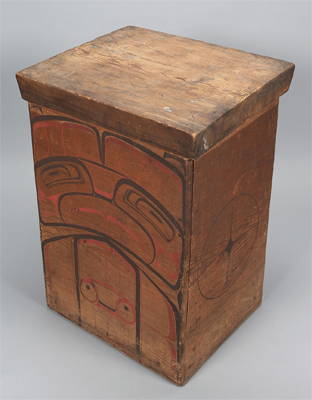
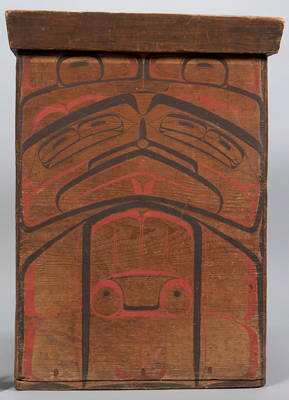 Galüünx (Bentwood Box)
Galüünx (Bentwood Box)
Tsimshian
Lax Kw'alaams (Port Simpson, BC), ca 1880
Nb3.1481 a-b
Visible on this box is a bright-red trade pigment, vermilion. It was likely introduced to coastal peoples in the late 1700s or early 1800s, when fur traders returned from China with goods to trade for sea-otter pelts.
Tall square bentwood box (part a) with a slightly flared lid (part b). The front and back are painted red and black in different distributive Northwest Coast stylized designs. The front has raven-like features with bird heads for eyes. The back depicts an eagle with a large crest on its forehead made of u and split u-forms. The sides display a large black circle with a cross in the middle illustrating the fore directions. Joining corner nailed together with wooden pegs.
Bentwood boxes were used primarily for storage of food, implements, clothing and valuables. They were also used for cooking and serving food. They sometimes served as furniture or room dividers. They were also used as trade goods or gifts, and were symbols of wealth and prestige. Boxes used for ceremonial purposes were usually more highly decorated than those for everyday use.
Heiltsuk style painted box.
Owned by Margaret E. Cornish and E. Percival before January 18, 1988
Received from Margaret E. Cornish (Seller), Museum of Anthropology Shop Volunteers (Funding source) and E. Percival (Seller) on January 18, 1988
Kerfed, painted, steamed, pegged and bent
Part a: height 650 mm, width 485 mm, depth 400 mm
Part b: height 75 mm, width 525 mm, depth 450 mm
Condition: good
Accession number: 1283/1 a-b
Photo (top left): Don Hitchcock 2012
Photo (all others) and text: http://www.rrnpilot.org/items/23143
 Kakatc.kanci (Painted Storage Box)
Kakatc.kanci (Painted Storage Box)
(This example is very similar to the one above, possibly by the same maker - Don )
Culture: Haisla
Tall square wooden box (part a) with flared lid (part b). The front and back are painted red and black in two different Northwest Coast stylised designs; the front has bird-like features. The sides have different motifs of sets of ovoids and split u-forms. The lid is slightly flared and unpainted. Square box is steam bent. Joining corner and base are nailed together.
Bentwood boxes were used primarily for storage of food, implements, clothing and valuables. They were also used for cooking and serving food. They sometimes served as furniture or room dividers. They were also used as trade goods or gifts, and were symbols of wealth and prestige. Boxes used for ceremonial purposes were usually more highly decorated than those for everyday use.
Heiltsuk style box.
Made in Kitamaat, British Columbia, Canada
Ca 1880 - 1900
Owned by George Henry Raley before November 1948
Received from H. R. MacMillan (Funding source) and George Henry Raley (Seller) during November 1948
Identification Number: A6568 a-b
Manufacturing Technique: kerfed, painted, nailed, bent and steamed
Part A: height 54 cm, width 42 cm, depth 36 cm
Part B: height 7 cm, width 45 cm, depth 39 cm
Accession number: 1960/500 a-b
Photo and text: http://www.rrnpilot.org/items/8928
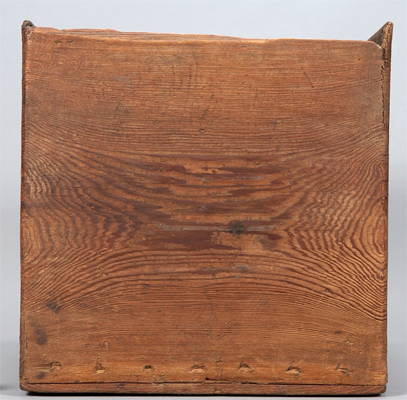
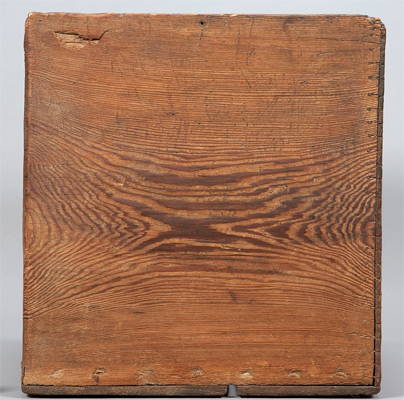 Ink (Cooking Box)
Ink (Cooking Box)
Gitxsan
Kisgegas, BC
Nb7.341
Red cedar, sewn with cedar withes
ca 1840 - 1860
Tom Marshall Collection, 1991
Watertight cooking boxes were used to boil or steam foods such as fish, seaweed, and dried berries.
Placed beside the fire, the box was partly filled with water. The cook would drop red-hot stones inside to bring water to the boil. Foods would then be added, sometimes held in an openwork basket.
Beginning in the late 1700s, such boxes were gradually replaced by iron pots acquired through trade.
This is described as a large square bentwood box with uneven upper edges. The joining corner and the bottom are sewn together with strips of twisted cedar rope.
Height 555 mm, width 540 mm, depth 510 mm
Condition: good
Accession number: 1454/1
Photo (top left): Don Hitchcock 2012
All other photos and some text: http://www.rrncommunity.org/items/25329
Source and additional text: Display, Museum of Anthropology, University of British Columbia
Fitting Boards together
In some cases it is necessary to fit boards together with great accuracy; for instance, when fitting the sides of a box to its bottom. This is done in the following manner. The piece of wood to which another piece is to be fitted is smeared all along its edge with wet powdered charcoal, which is kept in a clam shell. Then it is pressed against the other piece, which has been fitted as near as possible in the desired form. Wherever there is an inaccuracy in the fitting, the charcoal produces black spots. These places are shaved off, until in the final fitting the charcoal forms one even continuous black line. When such pieces are to be fitted together so as to be watertight, they are first rubbed with tallow and rotten pitch-wood.
Text above: Boas (1909)
References
- Boas, F., 1909: The Kwakiutl of Vancouver Island, Stechert & Co, 1909
- Boas, F., 1956: Primitive Art, Courier Dover Publications, 01/06/1955 - 378 pages
- Davidson, S., 1980: Fine Woodworking - Kerf-Bent Boxes, May/June 1980, no 22
- Hawthorn, A., 1967: Art of the Kwakiutl Indians and other Northwest coast tribes, University of British Columbia, 1967
- Inverarity, R., 1967: Art of the Northwest Coast Indians, Second Edition, University of California Press, 01/08/1967
- Jonaitis, A., 2006: Art of the Northwest Coast, University of Washington Press, October 1, 2006
- Savard, D., 2005: Changing Images: Photographic Collections of First Peoples of the Pacific Northwest Coast Held in the Royal British Columbia Museum, 1860-1920BC Studies, no. 145, Spring 2005
- Stewart, H., 1979: Looking at Indian Art of the Northwest Coast, Douglas & McIntyre, 1979
Back to Don's Maps
 Back to Archaeological Sites
Back to Archaeological Sites
 Back to Pacific NW Coast index
Back to Pacific NW Coast index
